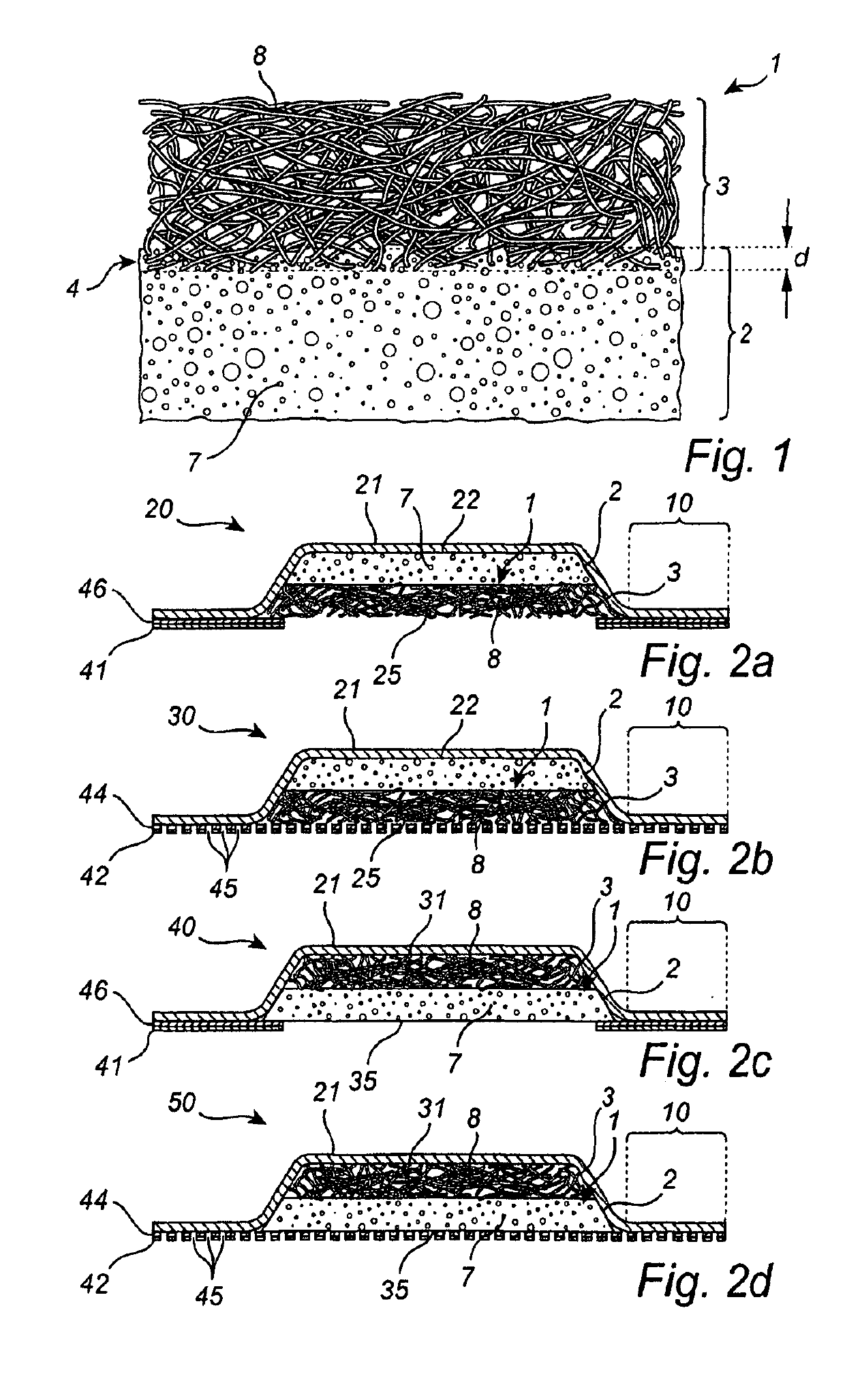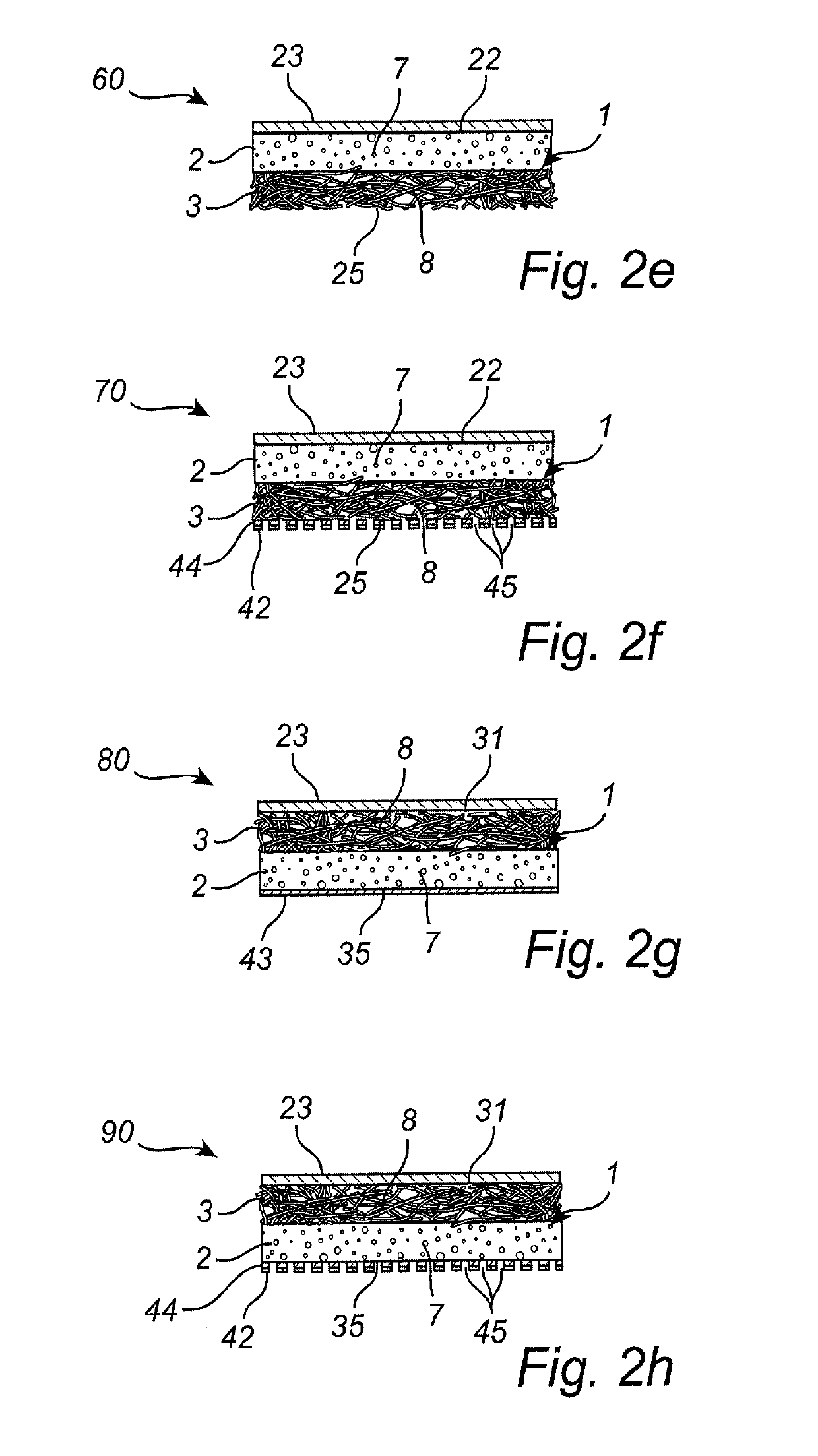Composite materials in wound treatment
- Summary
- Abstract
- Description
- Claims
- Application Information
AI Technical Summary
Benefits of technology
Problems solved by technology
Method used
Image
Examples
example 1
[0118]A first composite material was prepared by the following steps (1-6): (1) an aqueous mixture consisting of the following chemicals were prepared (commercially available from BASF): sodium bicarbonate 1.5% w / w, Pluronic® L62 0.01% w / w, and citric acid 0.002% w / w; (2) the aqueous mixture was mixed with Baymedix FP-505 (an HDI based prepolymer composition commercially available from Covestro) at a 1:5 ratio by weight (i.e. 1 part of aqueous mixture to 5 parts of HDI based prepolymer) to give an emulsion mixture; (3) the emulsion mixture was poured onto and spread out on a casting paper (20×30 cm); (4) an Exufiber® dressing (20×30 cm; 260 gsm, including cross-linked PVA fibers, commercially available from MöInlycke Health Care) was applied on top of the emulsion; (5) the product was allowed to cure at standard condition (at room temperature) to give a foam thickness of about 3 mm (foam thickness is controlled by adapting the thickness of spread of the emulsion mixture in step (3);...
example 2
[0119]A second composite material was prepared on an automated Pilot Production Line by the following steps (1-6): (1) an aqueous mixture was prepared using Pluronic® L-62 (commercially available from BASF) at a concentration of 0.14 wt %; (2) the aqueous mixture was then metered and mixed with Trepol® B-1 (a TDI based prepolymer commercially available from Rynel Inc.) at a ratio of 1:3.2 by weight (i.e. 1 part of aqueous mixture to 3.2 parts of TDI based prepolymer), using a standard Pin-type mixer to give an emulsion mixture; (3) when thoroughly mixed the emulsion (produced in step 2) was fed through a coat-hanger die and cast onto a siliconized casting paper; (4) an Exufiber® dressing material was fed from a roll and applied to the top of the curing emulsion; (5) the product was allowed to cure at standard condition (at room temperature) to give a foam thickness of about 2.5 mm (foam thickness is controlled by adapting the thickness of spread of the emulsion mixture in step 3); a...
example 3
[0120]The method of Example 1 was also used to prepare a third composite material wherein an Aquacel® dressing (including CMC fibers; commercially available from ConvaTec) was applied in step 4 (instead of the Exufiber® dressing above).
[0121]Method and Result of Measuring Penetration Depth
[0122]The penetration depth was measured using a stereoscopic microscope with micrometer scale, that is, the physical interaction volume between the foam and fiber layers was identified using the microscope and the penetration depth, corresponding to the depth of the physical interaction volume in the direction of the thickness of the layers / composite material, was measured using the micrometer scale. The penetration of Prototype A, as measured accordingly, was estimated to be about 50 μm.
[0123]Method and Result of Measuring Peel Strength
[0124]The peel strength was measured using the standard method ASTM D6862-11 (11th revision, 90 degree peel strength test). The peel strength test on the wound pad...
PUM
| Property | Measurement | Unit |
|---|---|---|
| Length | aaaaa | aaaaa |
| Fraction | aaaaa | aaaaa |
| Fraction | aaaaa | aaaaa |
Abstract
Description
Claims
Application Information
 Login to View More
Login to View More - R&D
- Intellectual Property
- Life Sciences
- Materials
- Tech Scout
- Unparalleled Data Quality
- Higher Quality Content
- 60% Fewer Hallucinations
Browse by: Latest US Patents, China's latest patents, Technical Efficacy Thesaurus, Application Domain, Technology Topic, Popular Technical Reports.
© 2025 PatSnap. All rights reserved.Legal|Privacy policy|Modern Slavery Act Transparency Statement|Sitemap|About US| Contact US: help@patsnap.com


